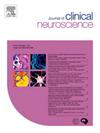评估血流分流器在小儿脑动脉瘤治疗中的有效性和安全性:系统回顾和荟萃分析。
IF 1.9
4区 医学
Q3 CLINICAL NEUROLOGY
引用次数: 0
摘要
背景:颅内动脉瘤在儿童患者中并不常见,占所有颅内动脉瘤的比例不到 5%。尽管它们很罕见,但由于其非囊状形态,给治疗带来了显著的挑战。鉴于管道栓塞装置(PED)等血流分流器(FD)的使用率不断上升,因此非常有必要进行系统性回顾和荟萃分析,以评估其在儿科人群中的适用性,并评估其安全性和有效性:方法:根据 PRISMA 指南,在 Medline、Embase 和 Web of Science 数据库中进行检索。我们采用随机效应模型下的单比例分析和 95% 置信区间、I2 评估异质性,以及 Baujat 和敏感性分析来解决高度异质性问题。符合条件的研究包括患者人数≥3人的研究,研究重点为即时和最终闭塞、良好临床效果、并发症和死亡率等结果:分析包括七项研究,涉及 80 名患者,共 91 个动脉瘤。在 62 个病例中,49 个实现了立即闭塞,闭塞率为 90%(95% CI:74% 至 100%)。87 个动脉瘤中有 71 个最终闭塞,闭塞率为 88%(95% CI:78% 至 98%)。值得注意的是,67 位患者中有 59 位临床结果良好,比例为 92%(95% CI:83% 至 100%)。73 名患者中有 5 人出现并发症,发生率为 3%(95% CI:0% 至 11%)。总死亡率分析显示,72 名患者中有 5 人死亡,死亡率为 6%(95% CI:0% 至 12%)。然而,在研究与腹腔镜手术相关的死亡率时,没有患者死亡,死亡率为0%(95% CI:0%至3%):我们的系统综述和荟萃分析显示,对小儿颅内动脉瘤进行FD治疗的效果很好。我们观察到了较高的闭塞率和良好的临床效果,这表明该技术在短期内是安全有效的。然而,还需要进一步的研究来验证和扩展这些发现。本文章由计算机程序翻译,如有差异,请以英文原文为准。
Evaluating the efficacy and safety of flow diverter in pediatric cerebral aneurysm treatment: A systematic review and meta-analysis
Background
Intracranial aneurysms are uncommon in pediatric patients, accounting for less than 5% of all intracranial aneurysms. Despite their rarity, they present notable challenges because of their non-saccular morphology. Given the rising utilization of flow-diverter (FD) devices such as the Pipeline Embolization Device (PED), there’s a significant need for a systematic review and meta-analysis to evaluate their applicability for pediatric populations and assess their safety and efficacy.
Methods
Medline, Embase, and Web of Science databases following PRISMA guidelines. We used single proportion analysis with 95 % confidence intervals under a random-effects model, I2 to assess heterogeneity, and Baujat and sensitivity analysis to address high heterogeneity. Eligible studies included those with ≥3 patients and focused on outcomes such as immediate and final occlusion, good clinical outcomes, complications, and mortality.
Results
The analysis comprised seven studies involving 80 patients with a total of 91 aneurysms. Immediate occlusion was observed in 49 out of 62 cases with a rate of 90 % (95 % CI: 74 % to 100 %). Final occlusion was achieved 71 out of 87 aneurysms a rate of 88 % (95 % CI: 78 % to 98 %). Notably, good clinical outcomes were reported for 59 out of 67 patients, representing a rate of 92 % (95 % CI: 83 % to 100 %). Complications occurred in 5 out of 73 patients, with an incidence rate of 3 % (95 % CI: 0 % to 11 %). The total mortality analysis revealed that 5 out of 72 patients died, resulting in a rate of 6 % (95 % CI: 0 % to 12 %). However, when examining mortality related to the FD, no patients died, resulting in a mortality rate of 0 % (95 % CI: 0 % to 3 %).
Conclusion
Our systematic review and meta-analysis reveal promising outcomes for FD treatment in pediatric intracranial aneurysms. We observed high occlusion rates and favorable clinical results, suggesting that the technique is safe and effective in the short term. However, further studies are necessary to validate and expand upon these findings.
求助全文
通过发布文献求助,成功后即可免费获取论文全文。
去求助
来源期刊

Journal of Clinical Neuroscience
医学-临床神经学
CiteScore
4.50
自引率
0.00%
发文量
402
审稿时长
40 days
期刊介绍:
This International journal, Journal of Clinical Neuroscience, publishes articles on clinical neurosurgery and neurology and the related neurosciences such as neuro-pathology, neuro-radiology, neuro-ophthalmology and neuro-physiology.
The journal has a broad International perspective, and emphasises the advances occurring in Asia, the Pacific Rim region, Europe and North America. The Journal acts as a focus for publication of major clinical and laboratory research, as well as publishing solicited manuscripts on specific subjects from experts, case reports and other information of interest to clinicians working in the clinical neurosciences.
 求助内容:
求助内容: 应助结果提醒方式:
应助结果提醒方式:


